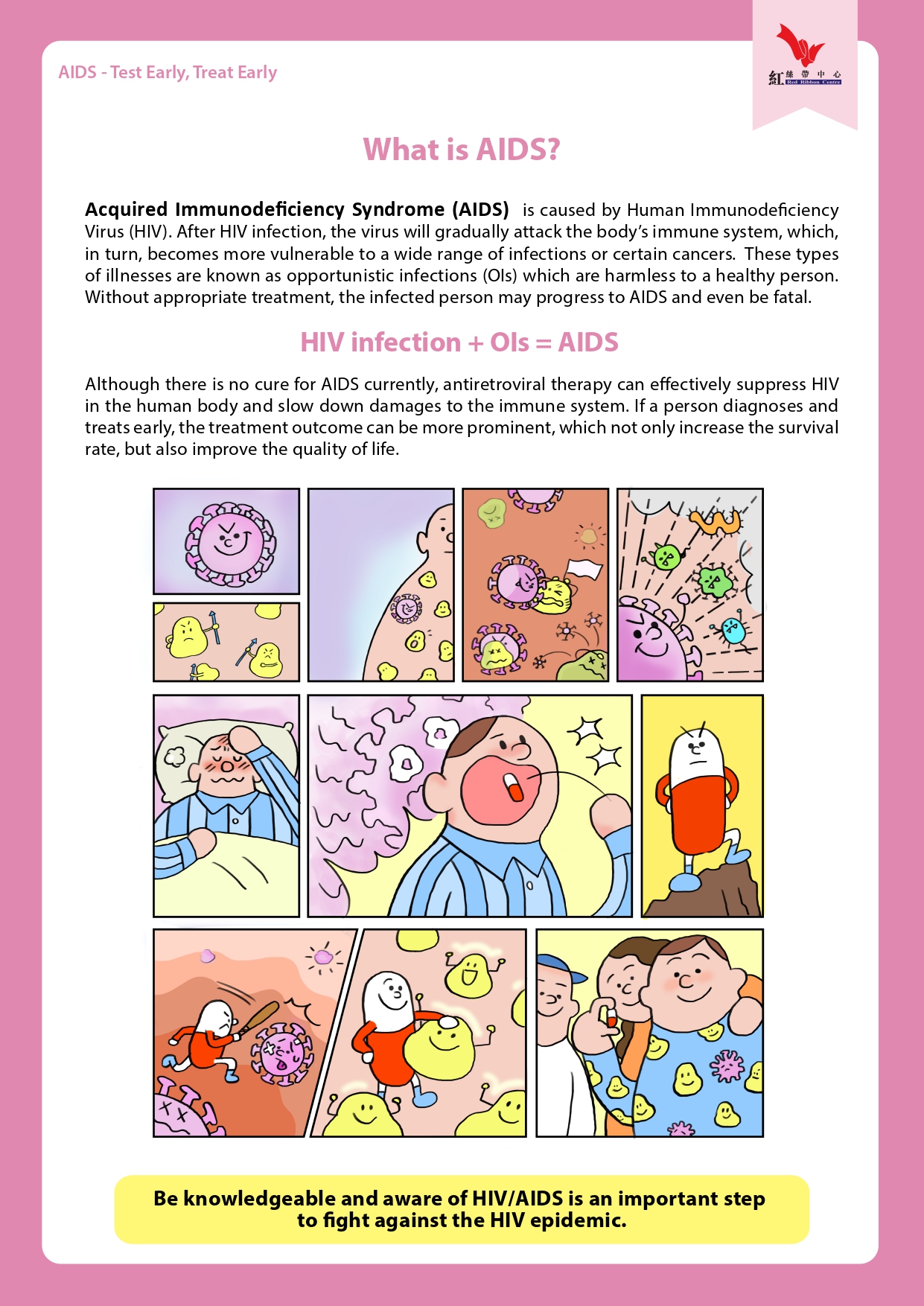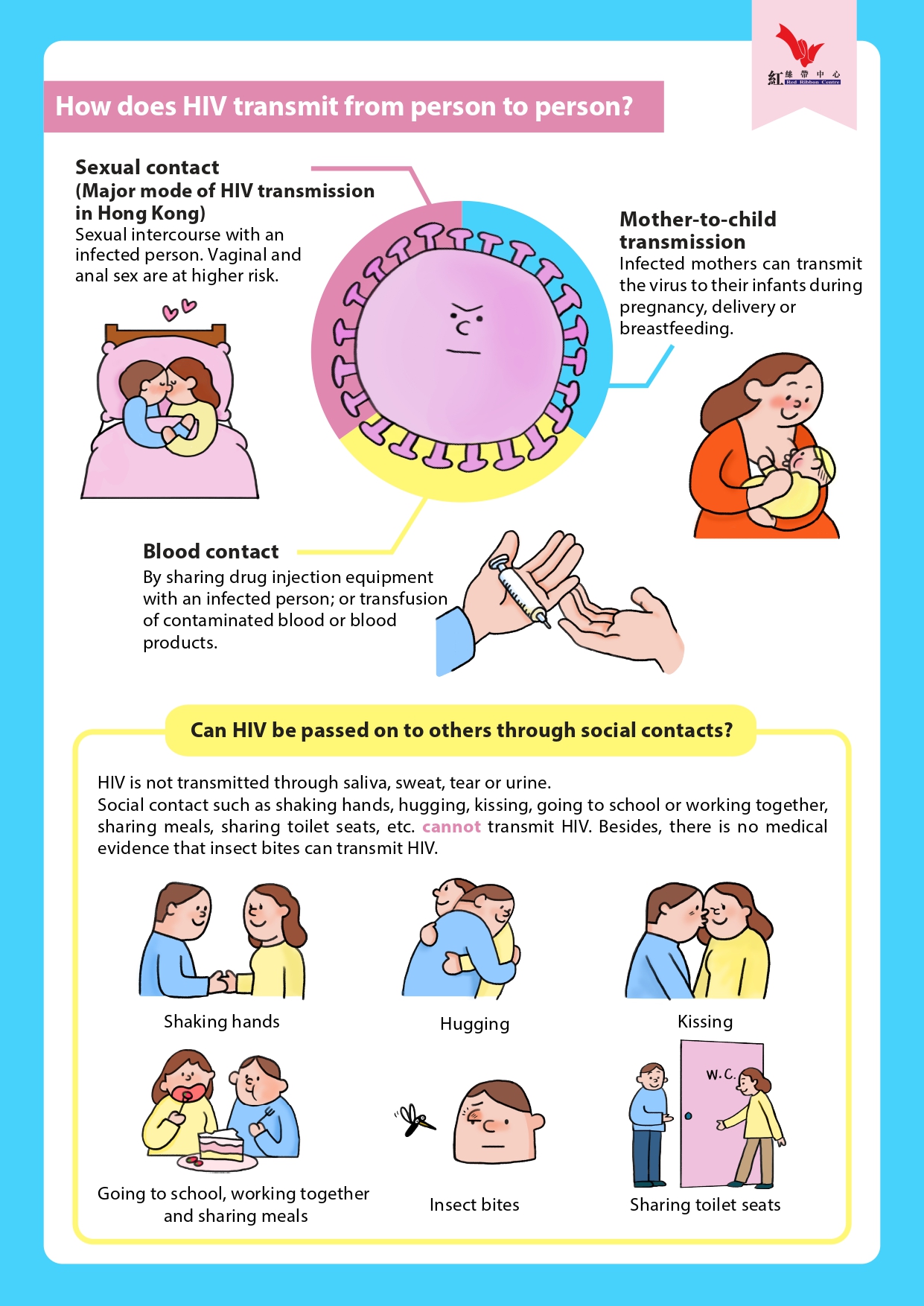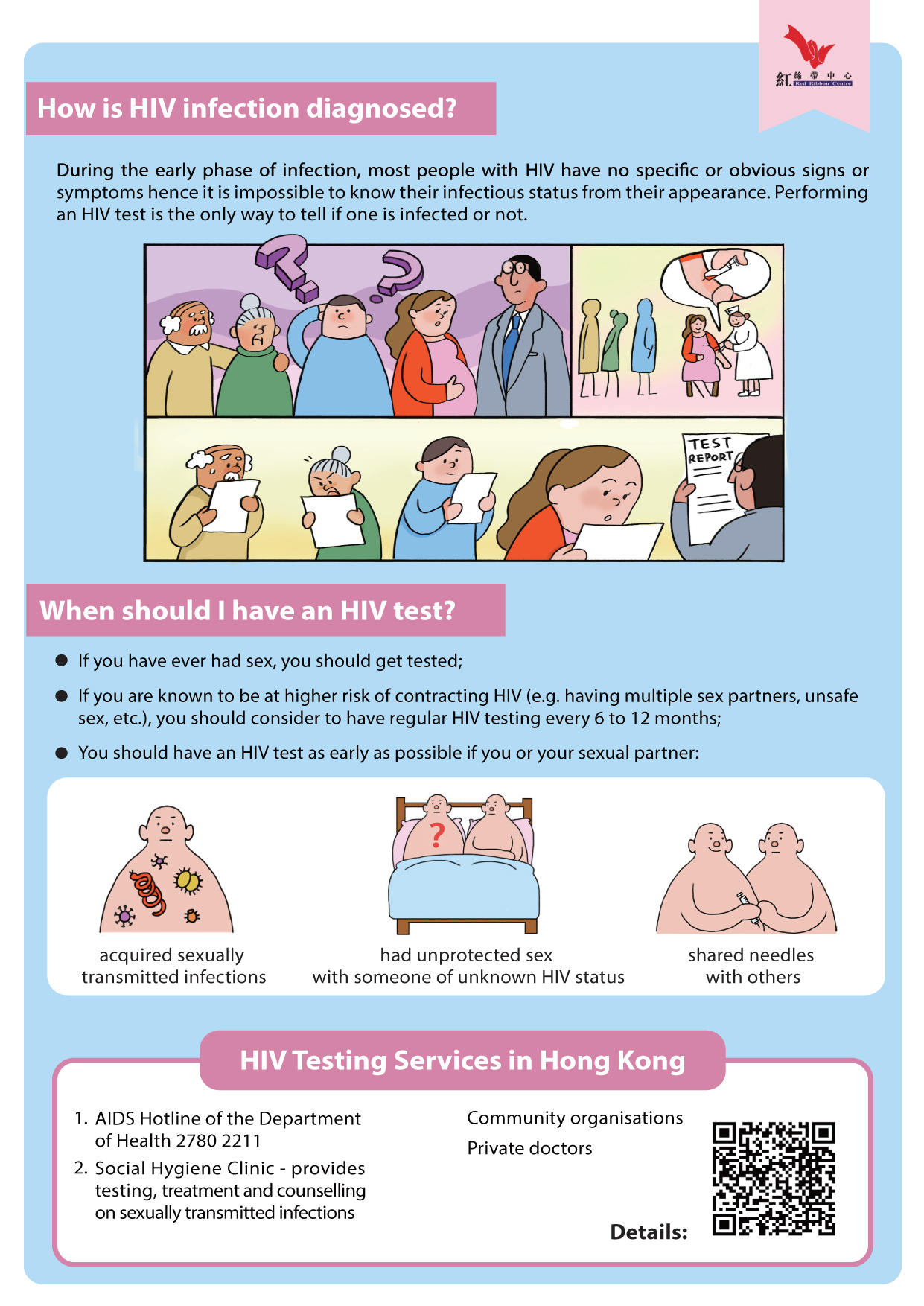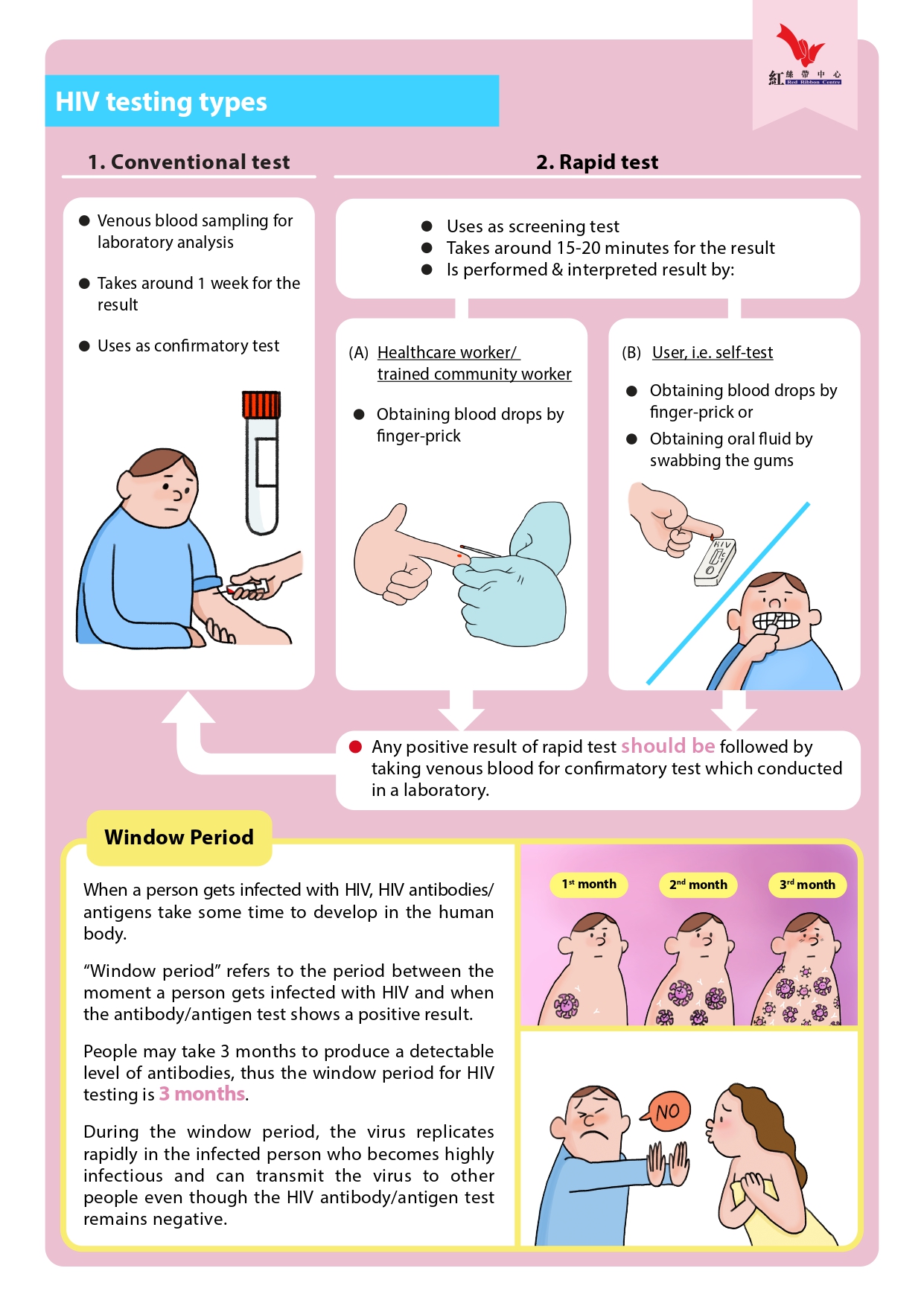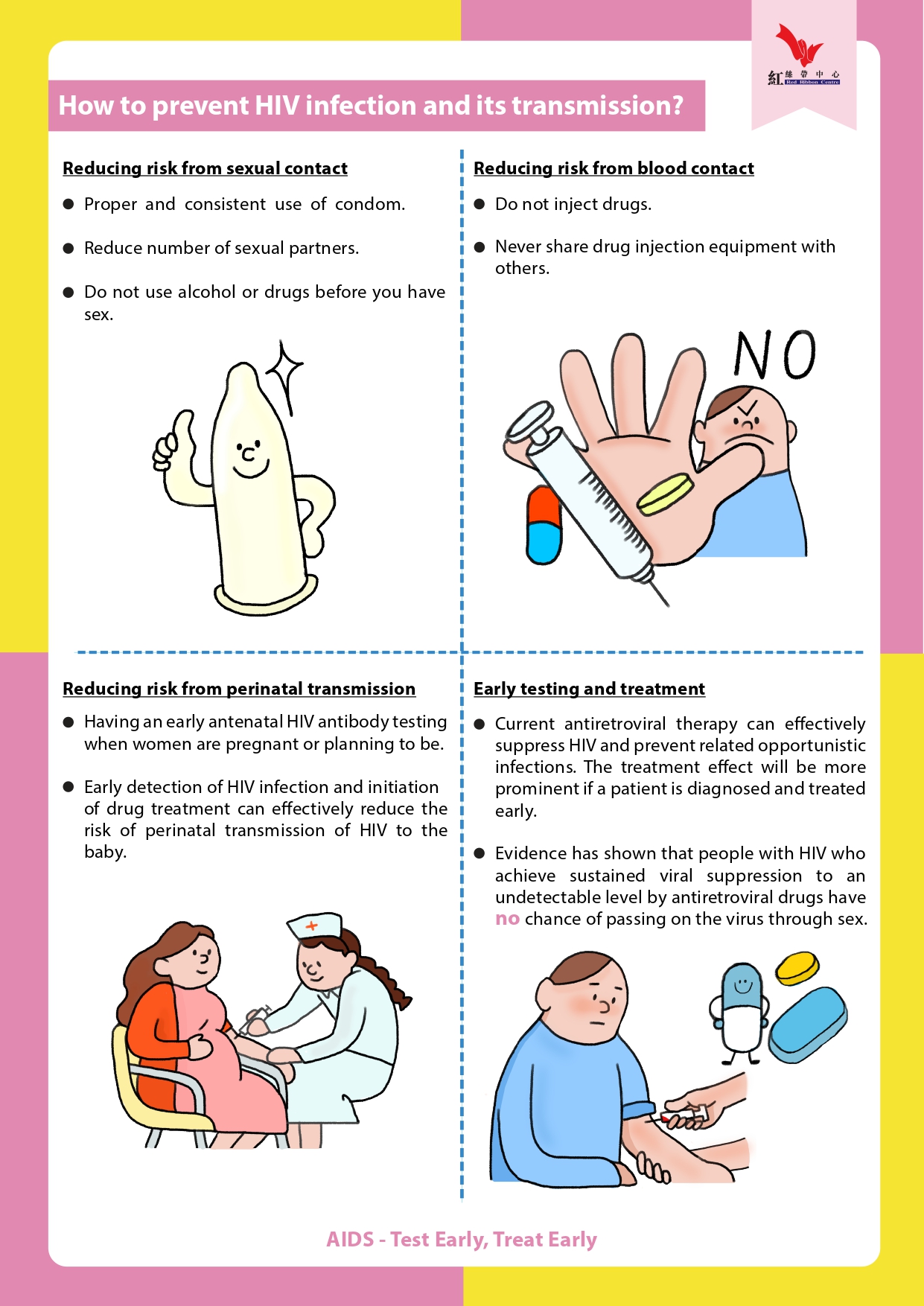Exhibition Board
AIDS - Test Early, Treat Early
Board 1 – What is HIV/AIDS?
- Acquired Immunodeficiency Syndrome (AIDS) is caused by Human Immunodeficiency Virus (HIV). After HIV infection, the virus will gradually attack the body’s immune system, which, in turn, becomes more vulnerable to a wide range of infections or certain cancers. These types of illnesses are known as opportunistic infections (OIs) which are harmless to a healthy person. Without appropriate treatment, the infected person may progress to AIDS and even be fatal.
Although there is no cure for AIDS currently, antiretroviral therapy can effectively suppress HIV in the human body and slow down damages to the immune system. If a person diagnoses and treats early, the treatment outcome can be more prominent, which not only increase the survival rate, but also improve the quality of life.
Be knowledgeable and aware of HIV/AIDS is an important step to fight against the HIV epidemic.
Board 2 - How does HIV transmit from person to person?
- Sexual contact (Major mode of HIV transmission in Hong Kong) - Sexual intercourse with an infected person. Vaginal and anal sex are at higher risk.
- Mother-to-child transmission - Infected mothers can transmit the virus to their infants during pregnancy, delivery or breastfeeding.
- Blood contact - By sharing drug injection equipment with an infected person; or transfusion of contaminated blood or blood products.
Can HIV be passed on to others through social contacts?
HIV is not transmitted through saliva, sweat, tear or urine.
Social contact such as shaking hands, hugging, kissing, going to school or working together, sharing meals, sharing toilet seats etc. cannot transmit HIV. Besides, there is no medical evidence that insect bites can transmit HIV.
Board 3 - How is HIV infection diagnosed?
During the early phase of infection, most people with HIV have no specific or obvious signs or symptoms hence it is impossible to know their infectious status from their appearance. Performing an HIV test is the only way to tell if one is infected or not.
When should I have an HIV test?
- If you have ever had sex, you should get tested;
- If you are known to be at higher risk of contracting HIV (e.g. having multiple sex partners, unsafe sex, etc.), you should consider to have regular HIV testing every 6 to 12 months;
- You should have an HIV test as early as possible if you or your sexual partner:
- acquired sexually transmitted infections,
- had unprotected sex with someone of unknown HIV status, or
- shared needles with others.
HIV Testing Services in Hong Kong
- AIDS Hotline of the Department of Health 2780 2211
- Social Hygiene Clinic - provides testing, treatment and counselling on sexually transmitted infections
- Community organisations
- Private doctors
Board 4 - HIV testing types
- Conventional test:
- Venous blood sampling for laboratory analysis
- Takes around 1 week for the result
- Uses as confirmatory test
- Rapid test:
- Uses as screening test
- Takes around 15-20 minutes for the result
- Is performed & interpreted result by
- Healthcare worker/ trained community worker
- Obtaining blood drops by finger-prick
- User, i.e. self-test
- Obtaining blood drops by finger-prick or
- Obtaining oral fluid by swabbing the gums
Any positive result of rapid test should be followed by taking venous blood for confirmatory test which conducted in a laboratory.
Window Period
When a person gets infected with HIV, HIV antibodies/antigens take some time to develop in the human body.
“Window period” refers to the period between the moment a person gets infected with HIV and when the antibody/antigen test shows a positive result.
People may take 3 months to produce a detectable level of antibodies, thus the window period for HIV testing is 3 months.
During the window period, the virus replicates rapidly in the infected person who becomes highly infectious and can transmit the virus to other people even though the HIV antibody/antigen test remains negative.
Board 5 - HIV Self-testing
Different HIV testing methods have their own strengths and weaknesses. “HIV self-testing” is a fast and convenient way of HIV screening with privacy ensured. At present, blood and oral fluid-based HIV self-test kits are available.
Brief of Collecting Different Sample
- User should follow the instructions provided by the test kit manufacturer.
Blood:
- Apply pressure to fingertip with the lancet.
- Squeeze out blood drop.
- Follow the instruction to add appropriate amount of blood sample to the sample port.
- Read test result at appropriate time.
Oral fluid:
- Take out the test device.
- Press the flat pad firmly against your gum. Swab it along upper gum and lower gum to collect oral fluid.
- Insert the flat pad of the test device into developer solution. Read test result at appropriate time.
For more information regarding HIV testing, please visit the HIV Testing website: www.hivtest.gov.hk
Board 6 - How to prevent HIV infection and its transmission?
Reducing risk from sexual contact
- Proper and consistent use of condom.
- Reduce number of sexual partners.
- Do not use alcohol or drugs before you have sex.
Reducing risk from blood contact
- Do not inject drugs.
- Never share drug injection equipment with others.
Reducing risk from perinatal transmission
- Having an early antenatal HIV antibody testing when women are pregnant or planning to be.
- Early detection of HIV infection and initiation of drug treatment can effectively reduce the risk of perinatal transmission of HIV to the baby.
Early testing and treatment
- Current antiretroviral therapy can effectively suppress HIV and prevent related opportunistic infections. The treatment effect will be more prominent if a patient is diagnosed and treated early.
- Evidence has shown that people with HIV who achieve sustained viral suppression to an undetectable level by antiretroviral drugs have no chance of passing on the virus through sex.
Produced by Red Ribbon Centre - UNAIDS collaborating Centre for Technical Support
Regulations for borrowing teaching aids
- The borrowing organisation (borrower) should contact Red Ribbon Centre (RRC) via phone (Tel: 3143 7200) or email rrc@dh.gov.hk) at least one week in advance for prior arrangement.
- Once approval is given, the borrower can approach the RRC during the office-hours for collection of the item(s).
- The borrower should produce proof of identity (e.g. staff ID card with photograph issued by the borrowing organisation) for completion of loan form before taking away the item(s).
- The borrower should return the item(s) in good condition within 14 days.
- If the borrower cannot return the item(s) within the foresaid period, RRC will reserve the right for further lending of teaching aids.
- In case of any loss or damage of the borrowed item(s), the borrower should notify RRC immediately and pay for the cost afterwards.
- No duplication of the teaching aids is allowed without prior approval of the Department of Health.
- The teaching aids are not allowed for commercial use.
- RRC reserves the ultimate right to lend the teaching aids to any organisation.
- For enquiries, please contact centre staff at Tel – 3143 7200
